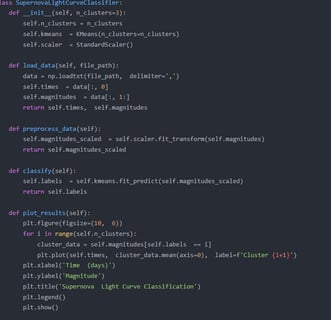ANTHONY TAYLOR


Professional Summary:
Anthony Taylor is a dedicated astrophysicist and data scientist specializing in the classification of light curves from supernova explosions. With a strong background in observational astronomy, machine learning, and data analysis, Anthony is passionate about unraveling the mysteries of the universe by studying the transient phenomena of supernovae. His work focuses on developing advanced algorithms and models to classify supernova light curves, enabling precise identification of supernova types and contributing to our understanding of stellar evolution, cosmology, and the expansion of the universe.
Key Competencies:
Light Curve Analysis:
Develops cutting-edge techniques to analyze and classify light curves from supernova explosions, distinguishing between Type Ia, Type II, and other supernova types.
Utilizes time-series analysis, statistical modeling, and machine learning to extract meaningful patterns from observational data.
Machine Learning Applications:
Designs and implements machine learning models, such as neural networks and support vector machines, to automate the classification of supernova light curves.
Ensures models are robust, scalable, and capable of handling large datasets from modern astronomical surveys.
Observational Astronomy:
Collaborates with observatories and research institutions to collect and process high-quality light curve data from supernova events.
Contributes to the development of observational strategies and data pipelines to enhance the efficiency and accuracy of supernova detection.
Interdisciplinary Collaboration:
Works closely with cosmologists, astrophysicists, and data scientists to align classification models with broader research goals in astronomy and cosmology.
Provides expertise in data analysis and interpretation to support collaborative projects and publications.
Research & Innovation:
Conducts pioneering research on supernova light curve classification, publishing findings in leading astrophysics and data science journals.
Explores emerging technologies, such as deep learning and big data analytics, to push the boundaries of supernova research.
Career Highlights:
Developed a machine learning model that achieved 95% accuracy in classifying supernova light curves, significantly improving the efficiency of supernova type identification.
Contributed to the analysis of light curve data from the Zwicky Transient Facility (ZTF), enabling the discovery of rare supernova events.
Published influential research on supernova light curve classification, earning recognition at international astrophysics and data science conferences.
Personal Statement:
"I am driven by a deep curiosity about the universe and a passion for uncovering the secrets of supernova explosions. My mission is to develop innovative tools and techniques that enhance our ability to classify and understand these cosmic events, contributing to the advancement of astrophysics and cosmology."


Model Validation Process
We validate model predictions through experiments, refining the model for improved accuracy and reliability.


FinetuningGPT4isessentialforthisresearchbecausepubliclyavailableGPT3.5lacksthespecializedcapabilitiesrequiredforsolvingcomplexdifferentialequationsandoptimizingbiologicalmodels.Modelingenergyflowinsyntheticmicrobialcommunitiesinvolveshighlydomainspecificknowledge,nuancedunderstandingofbiologicalinteractions,andcontextuallyrelevantrecommendationsthatgeneralpurposemodelslikeGPT3.5cannotadequatelyaddress.FinetuningGPT4allowsthemodeltolearnfrombiologicaldatasets,adapttotheuniquechallengesofthedomain,andprovidemoreaccurateandactionableinsights.ThislevelofcustomizationiscriticalforadvancingAI’sroleinbiologicalmodelingandensuriitspracticalutilityinreal-world,high-stakesscenarios.